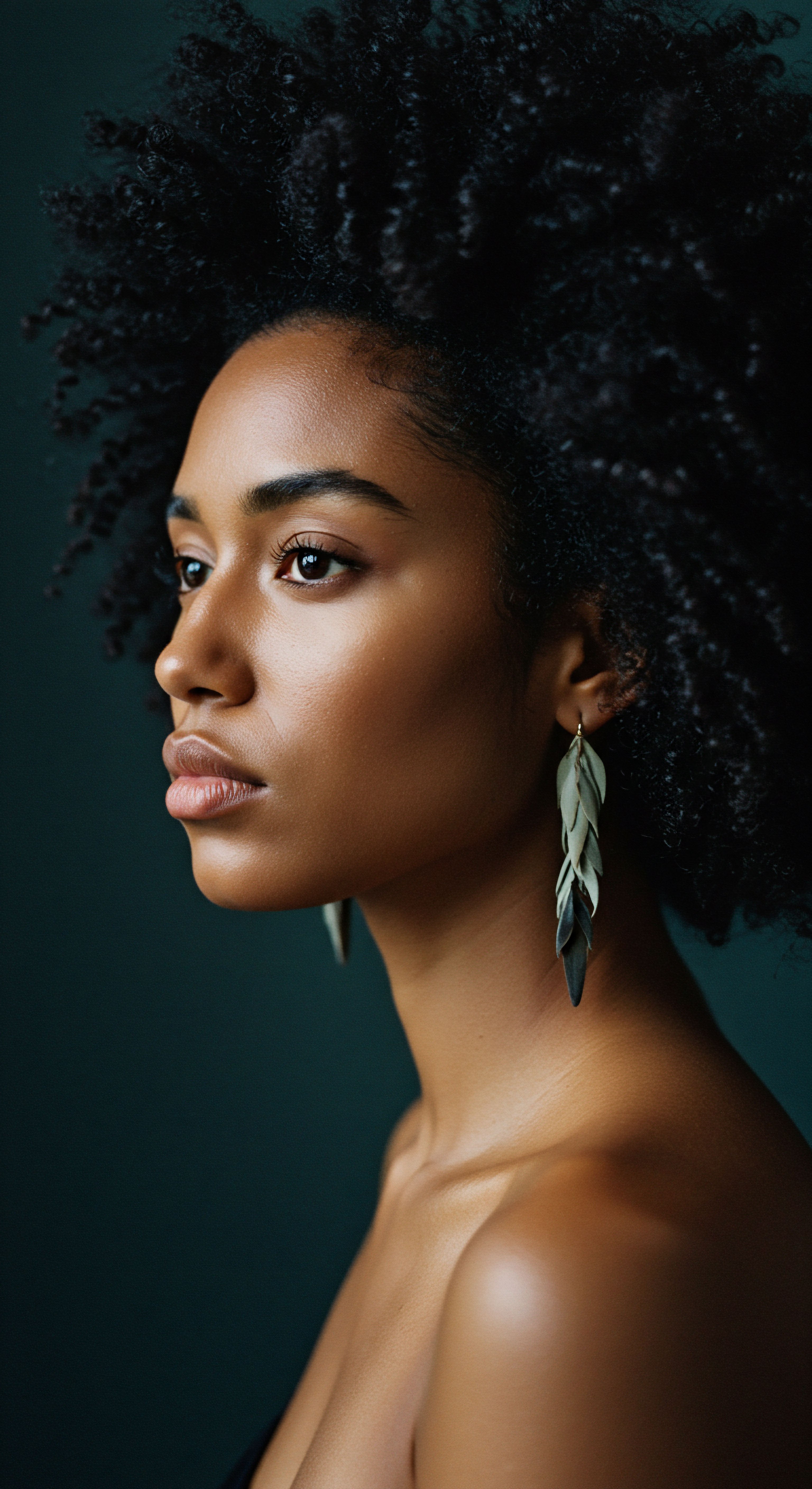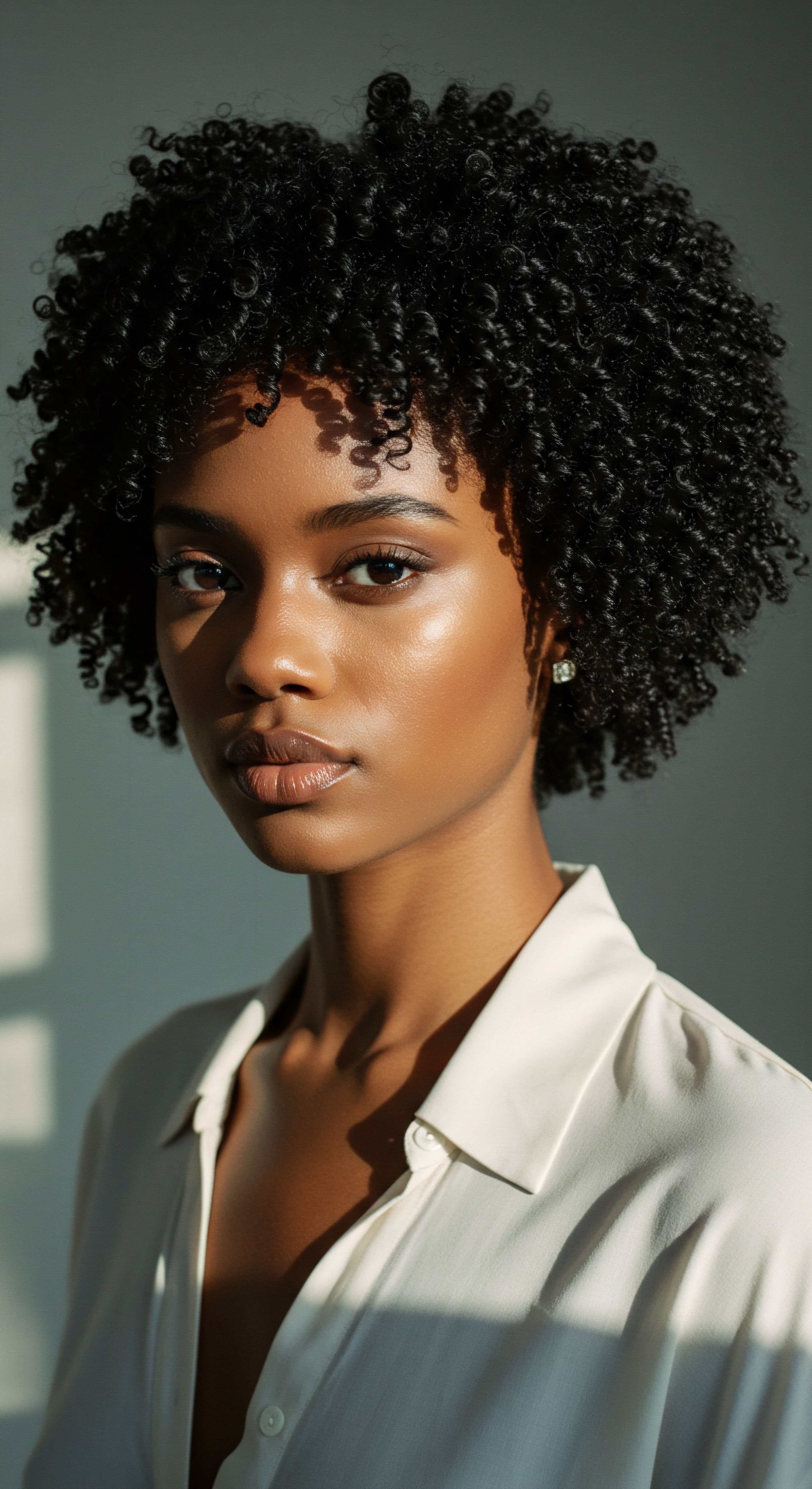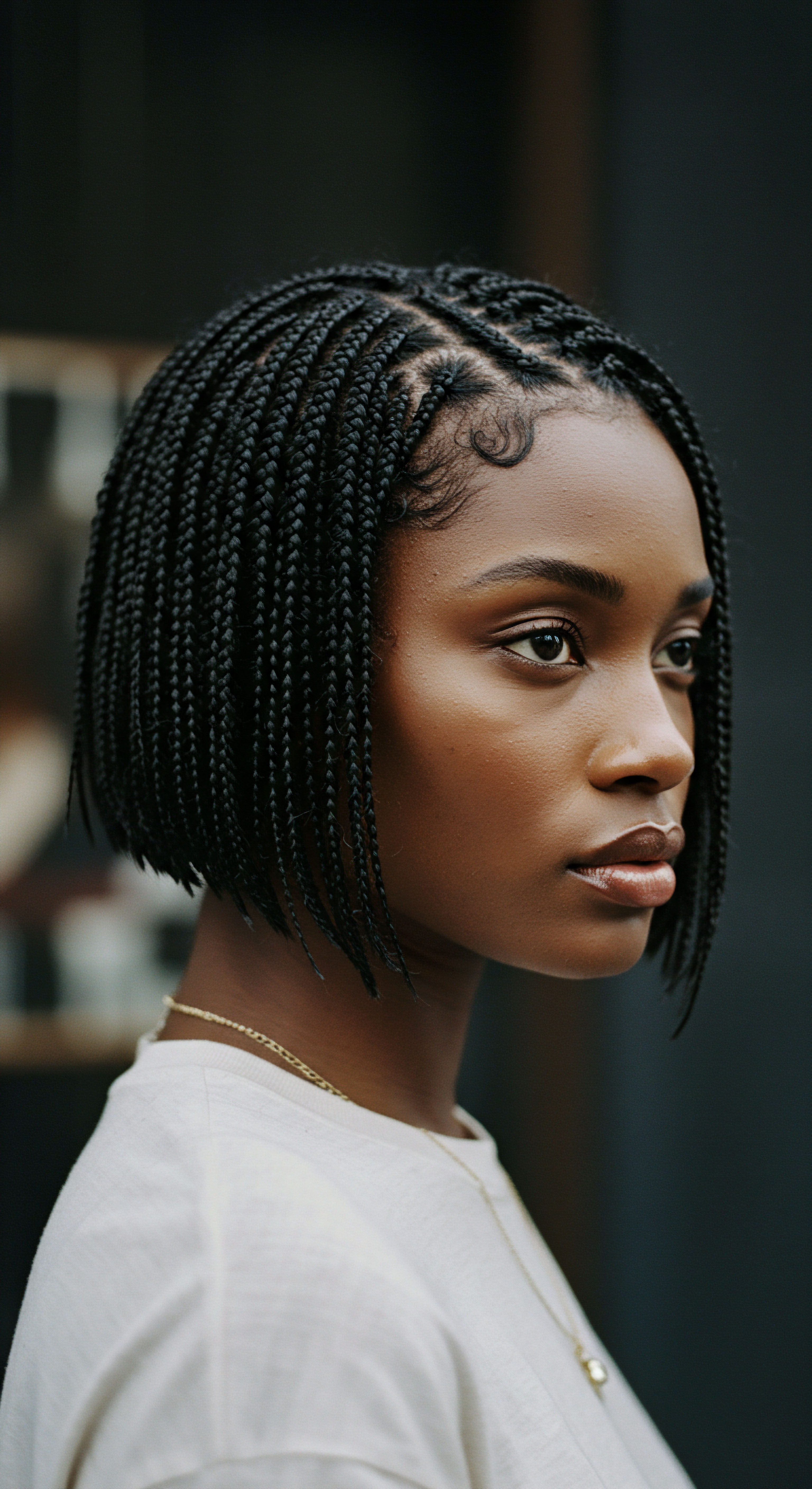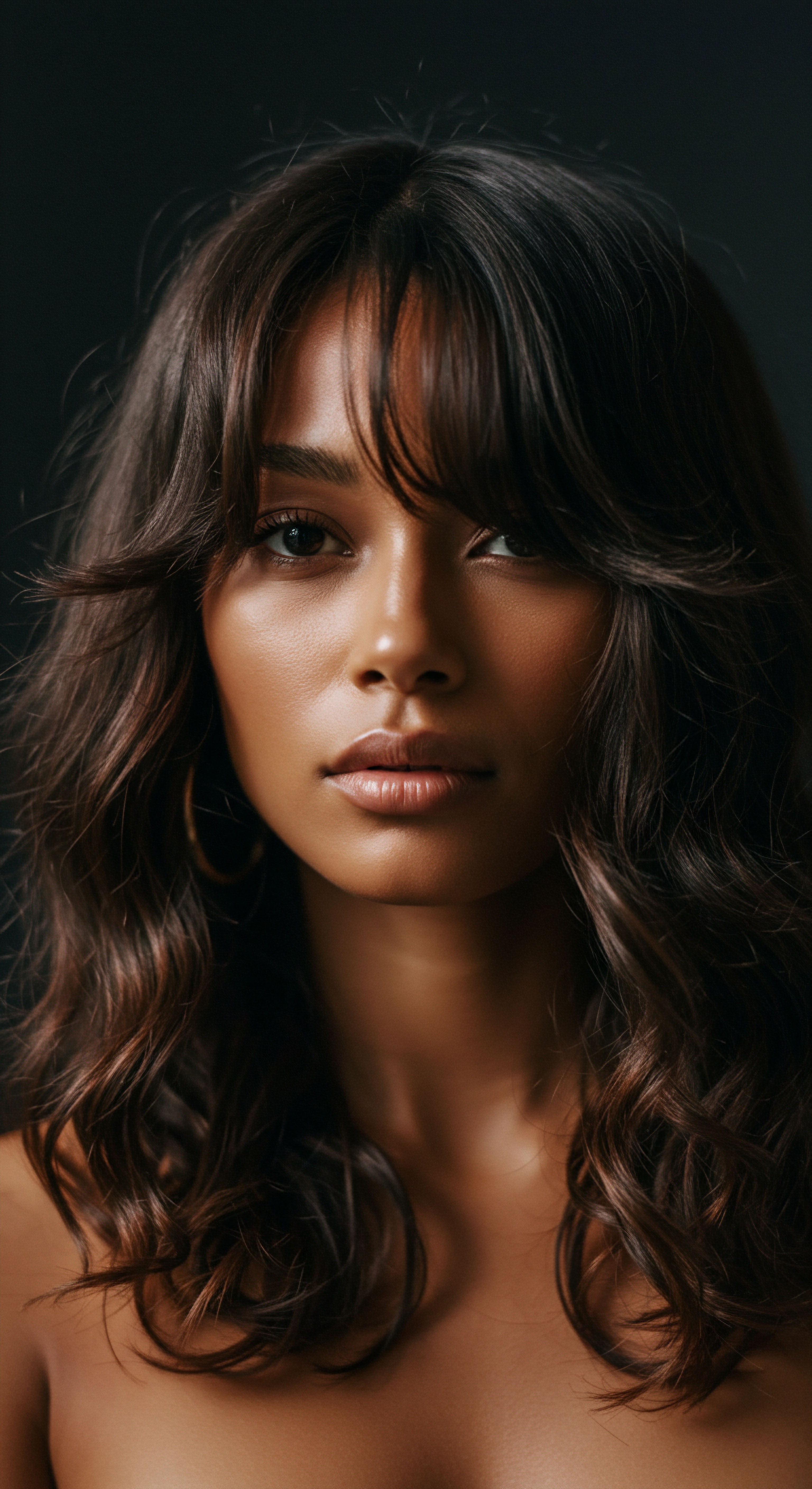
Roots
The journey to understanding our hair, particularly how its very nature predisposes it to vulnerability, often begins with a quiet observation ❉ some strands seem to drink in moisture with ease, while others resist, as if cloaked in an invisible shield. This simple daily experience, familiar to many, points to a deeper truth about hair’s structure and its inherent capacity for absorbing and retaining water. This capacity, known as porosity, is not merely a technical term for cosmetic chemists; it represents a fundamental aspect of hair’s identity, profoundly influencing its resilience and susceptibility to harm.
Hair porosity describes the extent to which hair absorbs and holds onto water, products, and treatments, directly linked to the integrity of its outermost layer, the cuticle. Think of the cuticle as a protective armor, a series of flattened cells overlapping like shingles on a roof. When these shingles lie flat and smooth, moisture struggles to enter or exit quickly.
When they are lifted, chipped, or absent, the hair becomes an open gateway, readily accepting and just as quickly releasing moisture. This inherent structural characteristic, often influenced by genetics and daily care practices, dictates how hair interacts with its environment and the world of products we introduce to it.

The Hair’s Protective Outer Layer
The cuticle, the hair’s primary defense, plays a central role in determining porosity. Each hair shaft consists of several layers ❉ the innermost medulla (present in some hair types), the resilient cortex which holds the hair’s color and strength, and the outermost cuticle. The arrangement and condition of these cuticle cells directly impact how much moisture the hair can absorb and retain.
A healthy, intact cuticle, with its cells lying flat, limits water absorption, allowing for controlled hydration. Conversely, a compromised cuticle, with lifted or damaged cells, allows for rapid water entry but also rapid water loss, leaving the inner cortex vulnerable.
Consider the profound differences in hair across ethnic groups. African hair, with its unique helical shape and flattened elliptical cross-section, often presents a higher natural porosity compared to straight hair types. This inherent configuration can lead to cuticle lifting at various points along the fiber, making it more prone to mechanical damage and increasing its overall porosity. This structural reality means that for many with textured hair, the conversation around porosity is not just about product absorption, but about fundamental protection and maintaining structural integrity against daily stresses.
Hair’s porosity, its capacity to absorb and hold moisture, is a fundamental indicator of its resilience and how it interacts with the world around it.

Is Porosity a Fixed Trait or Can It Change?
While genetics lay the initial blueprint for hair porosity, this characteristic is not immutable. Hair porosity exists on a spectrum and can shift over time due to various external influences. Repeated chemical treatments, such as bleaching, coloring, perming, or chemical straightening, are significant contributors to increased porosity.
These processes chemically alter the hair’s structure, degrading its protective F-layer (a lipid-based coating) and compromising the cuticle and cortex. Heat styling, excessive brushing, environmental exposure like UV radiation, and even the pH of hair products can also alter the cuticle’s integrity, leading to a more porous state.
A study employing a novel method, gas sorption, quantified how chemical damage from oxidative bleach nearly triples the hair surface area in the first minute of bleaching due to an increase in the number of pores. This initial surge is followed by a sudden drop as smaller pores break down into larger ones after about ten minutes. This scientific observation underscores the profound and rapid changes that chemical processes can inflict upon hair’s internal structure, directly impacting its porosity and subsequent vulnerability.
| Porosity Type Low Porosity |
| Cuticle Condition Tightly packed, flat cuticles |
| Moisture Behavior Resists water entry, slow to wet and dry |
| Product Interaction Products tend to sit on surface, can cause buildup |
| Porosity Type Medium Porosity |
| Cuticle Condition Slightly raised, moderately spaced cuticles |
| Moisture Behavior Absorbs and retains water well, balanced moisture |
| Product Interaction Products absorb effectively, generally predictable results |
| Porosity Type High Porosity |
| Cuticle Condition Lifted, damaged, or gapped cuticles |
| Moisture Behavior Absorbs water quickly, loses water quickly |
| Product Interaction Products absorb rapidly but may not provide lasting hydration, prone to dryness |
| Porosity Type Understanding these distinctions guides tailored care for optimal hair health. |

Ritual
As we move beyond the foundational understanding of hair’s intrinsic nature, our focus shifts to the daily practices and thoughtful choices that shape its well-being. The rhythmic application of products, the gentle caress of a comb, the deliberate choices made in our routines—these are the rituals that hold the power to either fortify or diminish our hair’s resilience. For those seeking to comprehend how hair porosity influences its susceptibility to damage, the answers lie not just in scientific definitions, but in the practical wisdom gained through attentive care.
Hair porosity, whether low, medium, or high, profoundly impacts how hair responds to moisture and treatments. High porosity hair, characterized by lifted or compromised cuticles, readily absorbs water but struggles to retain it, leading to persistent dryness, frizz, and increased vulnerability to breakage. This type of hair often feels rough to the touch and dries quickly after washing. Conversely, low porosity hair, with its tightly sealed cuticles, resists water penetration, taking a long time to wet and dry, and can experience product buildup.

Why Does High Porosity Hair Break Easily?
The very structure that allows high porosity hair to absorb moisture so quickly also renders it susceptible to damage. With its raised or missing cuticles and often increased cracking and holes in the cortex, high porosity hair has compromised structural integrity. This means it is more prone to issues such as weak strands, split ends, and persistent frizz. The excess moisture absorption can paradoxically make hair feel heavy or weighed down, yet still dry, because the moisture escapes just as rapidly as it enters.
Research indicates that high porosity hair is damaged hair, often due to protein loss. The addition of proteins in shampoos, conditioners, or leave-on products can be a beneficial remedy for highly absorbent hair. This helps restore the protein-moisture balance, enhancing overall hair health and aiding in recovery. A study from 2022 highlighted how washing hair with surfactants can cause proteins to dissolve, increasing cuticle gap size and making hair more porous.
This same study found that coconut oils could reduce this damage by limiting how much a surfactant could affect the hair’s inner structure, even helping to retain color better. This suggests that strategic product choices can significantly mitigate the vulnerabilities of porous hair.

How Do Different Porosity Levels React to Humidity?
The atmosphere itself plays a significant role in hair’s behavior, particularly for different porosity types. Humidity, essentially higher than average moisture levels in the air, interacts with the proteins in our hair. For high porosity hair, humidity can be a double-edged sword.
While it readily absorbs this atmospheric moisture due to its open cuticles, this absorption can lead to excessive swelling, frizz, and an unruly appearance. The repeated swelling and shrinking of the hair shaft, known as hygral fatigue, can weaken the hair over time and make it more susceptible to breakage.
For low porosity hair, the interaction with humidity is different. Because its tightly packed cuticles resist moisture absorption, water tends to remain on the outside of the hair strand. This can weigh down the hair, causing it to fall flat or appear limp. The key for all hair types, regardless of porosity, is to maintain adequate internal hydration, which leaves less room for external moisture to disrupt the hair’s structure.
Thoughtful care, from product selection to environmental awareness, becomes a protective shield for hair, particularly when considering its unique porosity.
Maintaining hair health involves understanding these subtle yet profound interactions. For high porosity hair, sealing in moisture becomes paramount. Products that create a protective barrier, like certain oils or serums, can help prevent rapid water loss. For low porosity hair, gentle heat (like a steamer) can help lift the cuticles to allow moisture to enter more readily, preventing product buildup.
- Low Porosity Hair often benefits from warm water rinses and steamers to encourage cuticle opening.
- High Porosity Hair requires deep conditioning treatments and sealing oils to retain moisture.
- Medium Porosity Hair generally thrives with balanced hydration and protein treatments as needed.

Relay
Stepping further into the complexities of hair, we encounter a deeper interplay where the very fabric of our strands, influenced by ancestral heritage and the demands of modern living, dictates its fate against damage. How does hair porosity, often a silent genetic whisper, become a loud determinant in its capacity to endure chemical alterations, environmental assaults, and the subtle wear of daily life? The answer lies in a sophisticated dialogue between inherent structure and external forces, a conversation particularly resonant for textured hair.
Porosity, at its most fundamental, speaks to the hair’s permeability. When we consider the unique characteristics of Afro-textured hair, its inherent structural features—such as its distinctive helical shape and elliptical cross-section—mean it often presents with naturally elevated porosity. This is not a deficit, but a design; however, this design does present particular vulnerabilities.
The natural twists and turns of coily hair can lead to points along the fiber where the cuticle layers are naturally lifted or prone to lifting, exposing the inner cortex more readily. This inherent configuration can predispose textured hair to greater mechanical damage and moisture instability.

Does Hair Porosity Affect How Chemical Treatments Damage Hair?
Chemical treatments represent a significant stressor for hair, and porosity acts as a critical mediator of this impact. Hair that is already porous, whether due to genetics or prior damage, will absorb chemical solutions more rapidly and intensely. This accelerated absorption can lead to more pronounced damage. Bleaching, for instance, is known to significantly increase hair porosity by degrading the protective F-layer and compromising the cuticle and cortex, creating microscopic voids within the hair shaft.
A study published in the Journal of Cosmetic Science highlighted that chemical damage from oxidative bleach can nearly triple the hair’s surface area in the initial moments of exposure, due to an increase in pore volume. This drastic alteration leaves the hair significantly more susceptible to further harm.
The relationship between chemical processes and hair damage is measurable. A study correlating porosity and tensile strength of chemically modified hair found that bleaching was the most damaging cosmetic treatment, followed by hair relaxers, then permanent waves, and finally permanent hair colors as the least damaging. The study demonstrated a strong correlation between increased porosity (measured by water uptake) and reduced tensile strength, validating porosity measurement as a less time-consuming method to quantify damage. This empirical evidence underscores the critical role porosity plays in determining the outcome and potential harm from chemical interventions.

How Does Porosity Influence Damage from Environmental Factors?
Beyond chemical interventions, environmental factors like humidity and UV radiation also interact with hair porosity to dictate damage susceptibility. High humidity causes highly porous hair to absorb excess moisture from the air, leading to swelling and frizz. This repeated swelling and subsequent drying can result in hygral fatigue, a process where the hair shaft is continuously stressed by changes in water content, weakening its structural integrity over time. For hair already compromised by high porosity, this cyclical stress can accelerate breakage.
UV radiation, particularly UV-B rays, degrades the protective cuticle layer and breaks down essential proteins within the hair shaft, accelerating porosity and weakening the hair. Hair with higher porosity, having a more open cuticle, allows for deeper penetration of these damaging rays, making it more vulnerable to oxidative stress and protein loss.
| Factor Genetics |
| Impact on Porosity Determines inherent cuticle structure |
| Damage Mechanism Predisposes to natural cuticle lifting in coils |
| Specific Relevance to Textured Hair African hair often has naturally higher porosity due to curl pattern |
| Factor Chemical Treatments |
| Impact on Porosity Increases porosity significantly |
| Damage Mechanism Degrades F-layer, compromises cuticle/cortex, creates voids |
| Specific Relevance to Textured Hair Relaxers can cause structural damage, porosity increase, and reduced strength |
| Factor Heat Styling |
| Impact on Porosity Increases porosity |
| Damage Mechanism Depletes moisture, deteriorates keratin fibers, leads to brittleness |
| Specific Relevance to Textured Hair Repeated heat styling on textured hair can lead to longitudinal cracks and increased combing work |
| Factor Mechanical Stress |
| Impact on Porosity Erodes cuticle layer, exposes inner layers |
| Damage Mechanism Friction, rough handling, tight styles cause wear |
| Specific Relevance to Textured Hair High curvature of textured hair makes it more prone to mechanical damage during combing |
| Factor UV Radiation |
| Impact on Porosity Degrades cuticle, breaks down proteins |
| Damage Mechanism Weakens hair, accelerates porosity formation |
| Specific Relevance to Textured Hair Can cause scaling and lifting of cuticles in African hair after exposure |
| Factor pH of Products |
| Impact on Porosity Alkaline pH opens cuticles, increases porosity |
| Damage Mechanism Increases negative charge, friction, cuticle damage |
| Specific Relevance to Textured Hair Using pH-balanced, slightly acidic products helps close cuticles and reduce porosity |
| Factor A confluence of factors determines hair's vulnerability, necessitating informed care strategies. |
The interplay of porosity with daily practices is particularly pronounced for textured hair. A study using light and scanning electron microscopy revealed that natural African hair, even when removed by combing, exhibits a significantly higher incidence of knotting and breaking of hair shafts compared to Caucasian and Asian hair types. A high proportion of these hair shafts showed features consistent with structural damage, including trichorrhexis nodosa and broken ends. This underscores that for textured hair, the intrinsic characteristics combined with styling practices can amplify damage, where porosity plays a central role in how much stress the hair can absorb before fracturing.
Hair’s response to damage is deeply intertwined with its porosity, a trait influenced by both inherent structure and external interactions.
Understanding this intricate relationship allows for more precise and preventative care. For instance, knowing that highly porous hair is more susceptible to protein loss and swelling, one might prioritize products that fortify the hair shaft with hydrolyzed proteins and use sealing oils to minimize moisture fluctuation. For low porosity hair, which resists product penetration, techniques like steaming or using lightweight, water-based products become more effective in ensuring adequate hydration without buildup.
The ongoing dialogue between hair’s natural state and the environment it navigates is a testament to its living, responsive nature. By discerning the language of porosity, we can craft care routines that truly honor and protect each unique strand.

Reflection
The journey through hair porosity reveals a profound truth ❉ our strands are not merely static fibers, but dynamic entities, each with a unique story of resilience and vulnerability. The way light dances off a healthy coil, the way a strand drinks in a nourishing oil, or the subtle resistance felt when detangling—these are all echoes of its porosity, a deep characteristic that shapes its destiny. It is a quiet conversation between the hair and its world, where every interaction, from the gentlest touch to the most transformative treatment, leaves an indelible mark. Understanding this intricate dialogue allows us to move beyond superficial fixes, guiding us toward a more profound, empathetic care that truly celebrates the inherent beauty and strength of textured hair, recognizing its delicate balance and honoring its every need.

References
- Davis-Sivasothy, Audrey. The Science of Black Hair ❉ A Comprehensive Guide to Textured Hair Care. Saja Publishing, 2011.
- Hessefort, Y. Z. Holland, B. T. & Cloud, R. W. “True porosity measurement of hair ❉ a new way to study hair damage mechanisms.” Journal of Cosmetic Science, 2008, 59(4), 303-315.
- Robbins, Clarence R. Chemical and Physical Behavior of Human Hair. Springer, 2012.
- Dias, M. F. R. G. “Hair cosmetics ❉ an overview.” International Journal of Trichology, 2015, 7(1), 2-15.
- Velasco, M. V. R. Dias, T. C. S. Freitas, A. Z. Vieira Júnior, N. D. Pinto, C. A. S. O. Kaneko, T. M. & Baby, A. R. “Hair fiber characteristics and methods to evaluate hair physical and mechanical properties.” Anais Brasileiros de Dermatologia, 2009, 84(4), 365-373.
- Sedik, Hadeer M. Gheida, Shereen F. Ibrahim, Wafaa M. & Doghaim, Noha N. “Effect of Hair Straightening Treatment on Porosity and Cysteic Acid Content of Hair.” Journal of Advances in Medicine and Medical Research, 2020, 32(18), 91-97.
- Gamini, A. & Khumalo, N. P. “Defying Damage ❉ Understanding Breakage in Afro-textured Hair.” Cosmetics & Toiletries, 2020, 135(1), 30-36.
- Paus, R. & Cotsarelis, G. “The Biology of Human Hair Greying.” Biological Reviews, 2021, 96(1), 107-128.
- Mohle, R.B. & Reles, S. “Effect of mineral oil, sunflower oil, and coconut oil on prevention of hair damage.” Journal of Cosmetic Science, 2003, 54, 175-192.
- Evans, T. & Wickett, R. “Adsorption Properties of Hair.” Practical Modern Hair Science. Allured Business Media, 2012, 333-365.